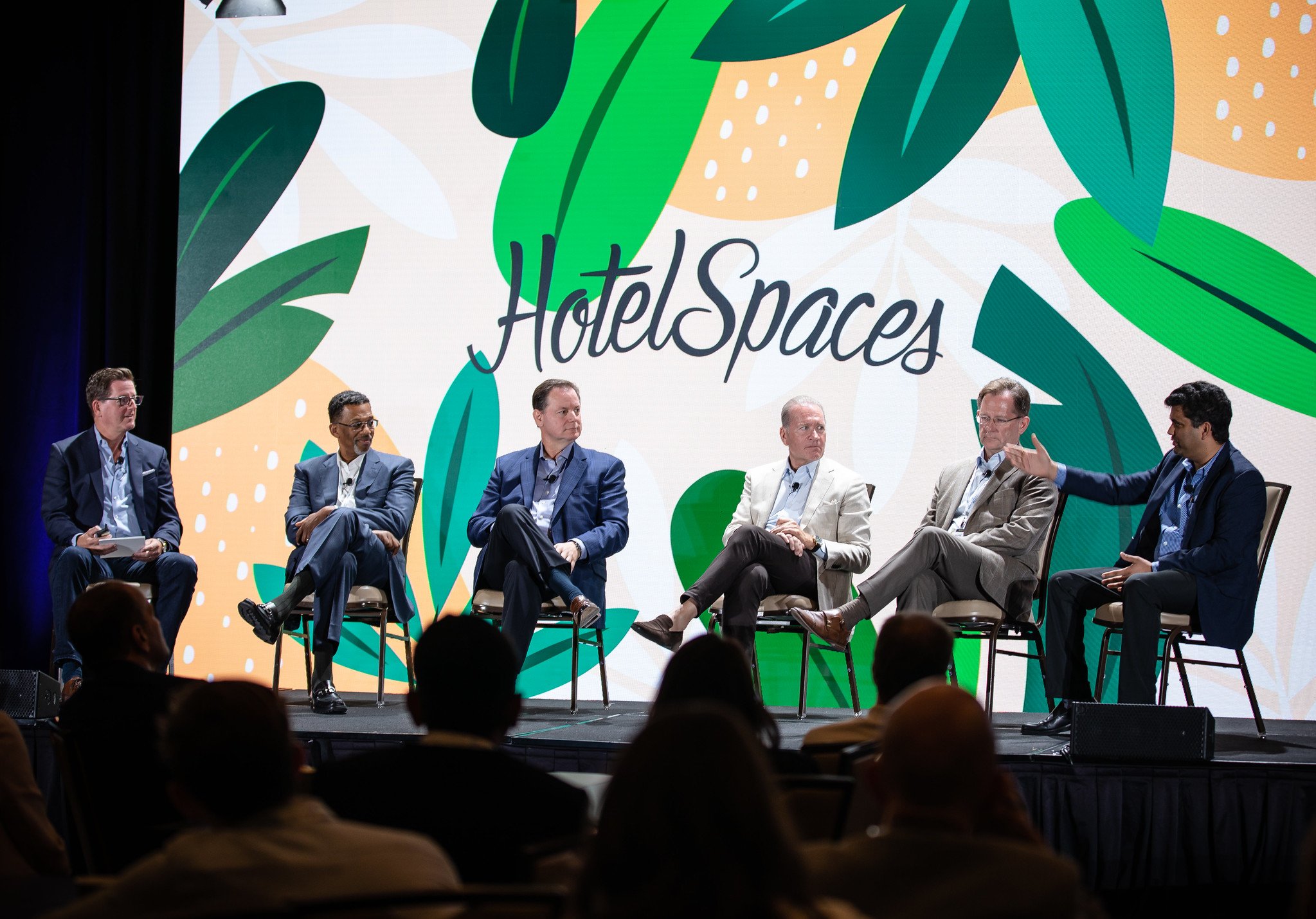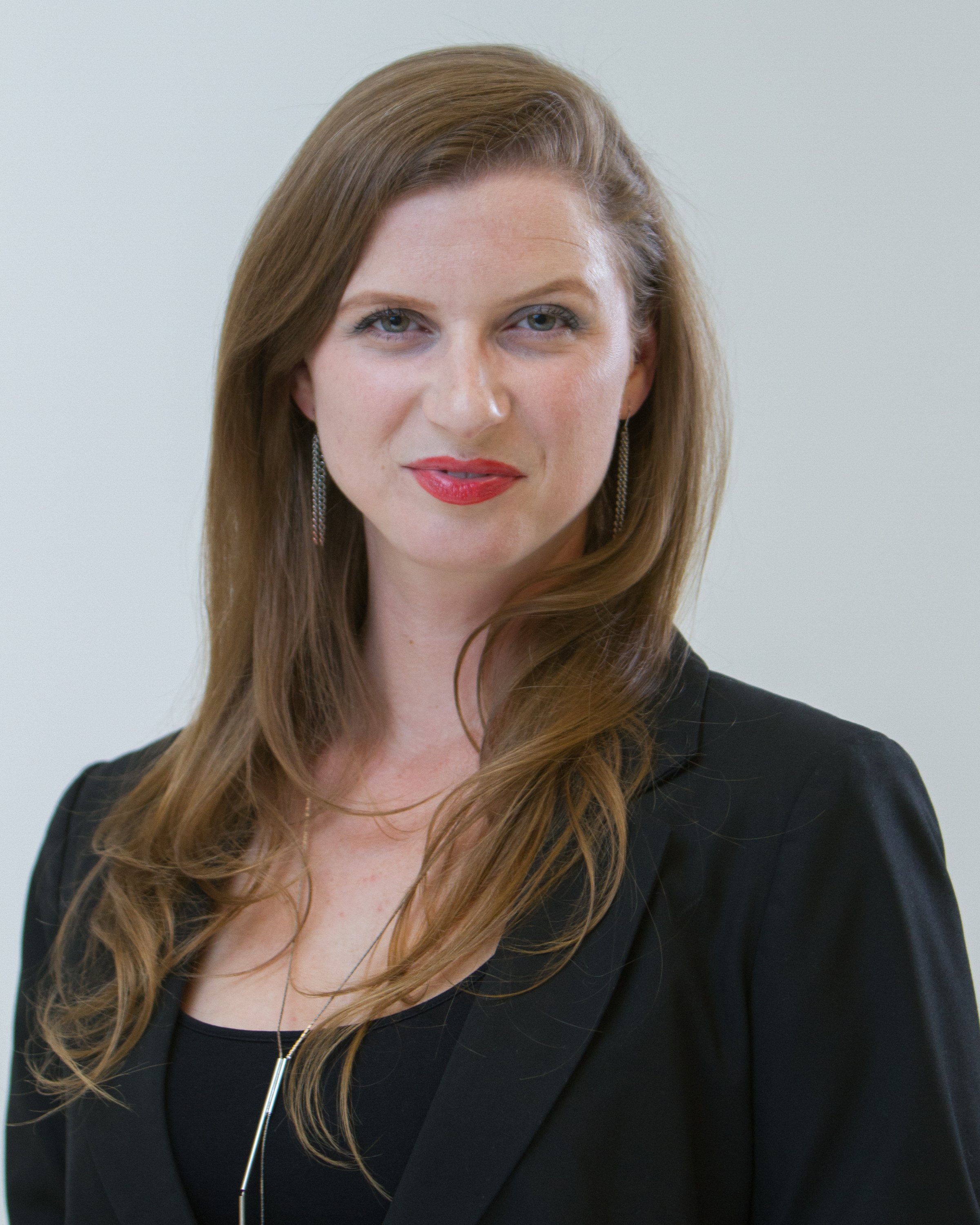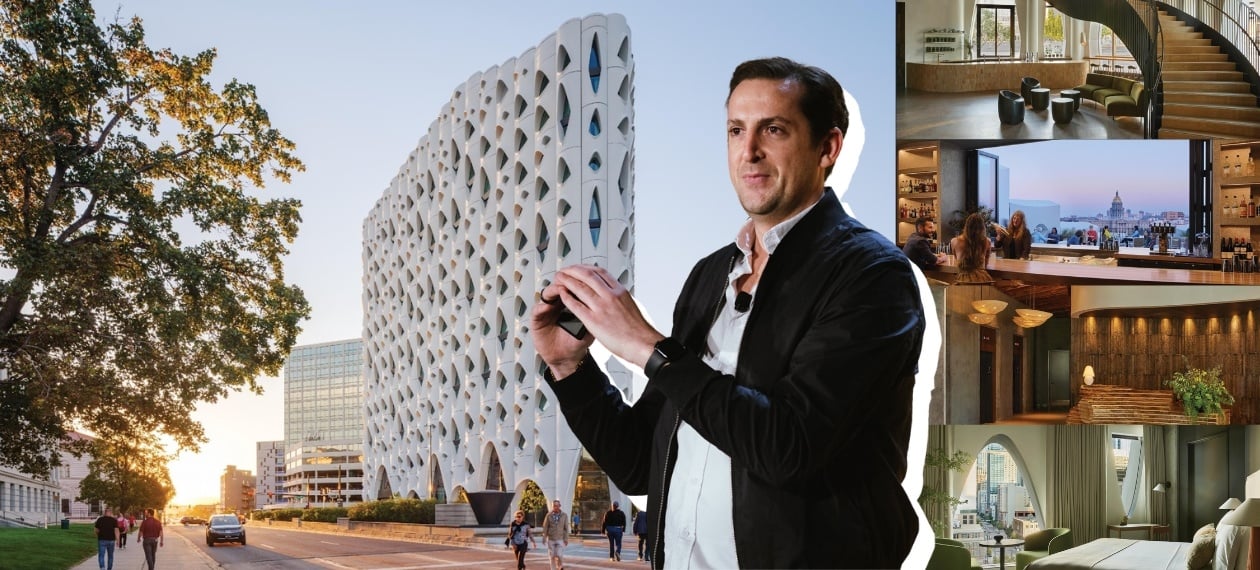In a wide-ranging discussion at HotelSpaces, moderator David Black—Managing Director of Project & Development Services for JLL's Hotels & Hospitality Group—led a diverse panel of hospitality leaders on the current state of hotel development, design, and construction.
New Models for Old Brands
Rising construction costs, labor shortages, restrictive policies towards immigration, and increases in tariffs continue to be a big concern for the industry, but hotel construction and investment remains high and the U.S. continues to be the strongest market. With all of that in mind, Black asked the members of the panel what some of their innovative approaches to development or renovations are, especially with industry trends favoring new brands and soft brands.
Gary Dollens, Global Head of Design & Brand Development at Hyatt, said that there are a lot of reasons to create new brands, whether there is a hole in the market or an opportunity to overlay an existing brand. Hyatt recently launched a new brand, Caption, that creates an opportunity for Hyatt to jump back into the top 200 domestic and international markets as well as define themselves differently with this new brand.
"We have an opportunity to [define this brand] a little more clearly, and that's one of the best reasons to have a lot of brands," he said. "If you are everything to everyone then you've got an issue, and it becomes harder to have a compelling story [to sell]."
Mike Lentz, EVP of Development, Design & Construction at Host Hotels & Resorts, said his company has been converting hard brands to soft brands.
"We do that when we see an opportunity to see the same top line revenue but bring in a more efficient manager and create more bottom line net operating income," he explained. They are also in the second year of a five-year transformational capital program in partnership with Marriott that has allowed them to spend in excess of escrow reserves in order to get operating profit guarantees for the incremental disruption associated with more significant, holistic renovations, "completely changing the economics" of such projects.
The Impact of Rising Costs
Black then asked the panel about their concerns over rising development costs.
Mark Boekenheide, SVP of Global Development at Las Vegas Sands, said they are seeing a lot of escalation because of rising tariffs and material costs, and they've also had problems getting permits from regulatory agencies in Singapore and Macau.
Carl Mayfield, EVP of Design & Construction at Park Hotels & Resorts, pointed out that the majority of those issues that used to have a 12-month life cycle now take 18 to 24 months to really bear out.
"It's placing more pressure on planning professionals [and everyone] in the life cycle to really bring their A game," he said.
Krishna Paliwal, President of the La Quinta brand and Head of Design & Construction for Wyndham Hotels & Resorts, said, "I believe necessity is the mother of invention. Now is the time for all of us, as designers, to think real hard; this is not the time for copy-and-pasting the plans from a previous project."
Little things, he continued, can have a big impact, like reducing the size of a credenza from 24 inches to 20 inches, making it both more environmentally friendly as well as cheaper in material costs. "This is a testing time where we all need to work together to create solutions to these problems," he said, adding that keeping things simple will help to carry this industry through its challenges.
Working with Brands
Black asked the owners on the panel about the biggest challenges and opportunities of working with brands.
Lentz noted that having so many different brands under one umbrella, each with their own brand standards, can drive a lot of costs, and their ability as owners to maintain and refresh hotels with new standards with traditional reserves has become a challenge. "Whenever we're looking at standards we view them through the lens of, 'Will we get our money back? Can we underwrite this incremental investment?'"
"Whenever we're looking at standards we view them through the lens of, 'Will we get our money back?"
Mayfield stated that the two stakeholder perspectives—the brand equity perspective and the owner equity perspective—have to be in balance so that both parties feel they're walking away with a "win," but Dollens reminded everyone that the ultimate winner always needs to be the customer.
"There shouldn't be a disconnect between the brand and the customer, and that's how we should be presenting it: There really is no 'brand standard' because the customer is driving this, and that's why you're going to a 65-inch television in all the rooms, because that has become the expectation," he said.
Mayfield said that's one of the challenges: the brand may have an initiative and the customer may have an initiative, but those initiatives aren’t one-size-fits-all. Owners have limited dollars that they need to spread across their entire portfolio while still maintaining relevance. There is a constant push-pull between the market, available resources, the brand, the ownership, and the customer.
Paliwal had a solution to that: "You need to set the expectation with the brand and make it very clear so you're not doing it twice."
The Impact of Mergers and Acquisitions
The next theme explored by the panel was regarding the impact of mergers and acquisitions on their projects. They all generally seem to have favorable experiences here, with Dollens noting that it creates more resources and also helps individual brands to define themselves. Mayfield praised the opportunity for brand and management diversification, flipping hard brands to soft brands, and providing a huge lift to the internal team.
Lentz said he is seeing a lot of operational improvements as a result of the Marriott-Starwood merger, as well as a 40 to 50 basis point margin improvement year over year since the merger. Eliminating competition and combining their reach has been a boon to the new company.
Paliwal noted there are cultural differences when two companies merge that need to be worked through, but it also allows them to "pick the best of both sides"—team members and practices—to create the best results.
Shifting Focus
When asked which sectors they're focused on most—select service, lifestyle, resort, convention, or luxury—panelists widely agreed that it depends on the market. Dollens said that in the Americas, select service is growing, but in China it's all about luxury. Boekenheide echoed this, saying that their Macau customers want nothing but the most exceptional, top-tier luxury.
Lentz said Host Hotels stays away from select service brands because the barrier to entry is low, which means there is a lot more competition. In areas where entitlements are difficult to get, they know someone else isn't going to come in and build the same thing. They favor lifestyle resorts in difficult-to-develop marketplaces because supply is the number one challenge to their ability to grow revenue and operating income.

Improving the Construction Process
Given tighter schedules with long lead times for construction and FF&E, Black asked the panel if there is a breakdown in the cycle somewhere and what they've been doing to reduce risk and improve processes.
Lentz said Host Hotels has a 10-year plan for each of the 84 hotels in their portfolio and manage business around their renovation cycles starting two years out. The problem is that once that schedule has been set, and rooms and meeting spaces have been blocked off, there isn't a lot of room for flexibility, and things like labor shortages and permitting delays can be a real challenge.
"We can afford to spend a little more on a capex project, but we can't afford to lose a piece of group business, because we'll lose them that year and the next year and maybe even the year after that before they trust us to come back again," he said. "We plan in advance as much as we can, but we have to work with issues outside of our control."
Mayfield has the same issues.
"The challenge for us is the unknown —a union strike, a regulatory change."
"The challenge for us is the unknown —a union strike, a regulatory change. We try to anticipate those things with a budget contingency and a schedule contingency, but we've had the greatest success avoiding fatal flaws by relying on the team. Where communication is high, the trust is high, and the work ethic is high, which allows us to manage the challenges we are confronted with in a typical project."
Boekenheide said Sands has changed processes, bringing in contractors earlier so they are working with the designers from the very beginning.
Paliwal echoed Mayfield in saying communication is key. "We want to make sure every day that the contractor is meeting with each sub saying, 'This is the expectation, this is today's schedule, this is what needs to happen.' The communication and bringing the right team on board at the right time are two key components."
The Impact of Technology
And, finally, technology. Black asked the panelists how their organizations are keeping up with the ever-changing nature of technology.
Boekenheide said that the younger demographic who grew up with cell phones in hand are now driving decisions as Sands goes into their next phase of capex work and developing new projects. Just a few years ago it was unheard of to check in with a cell phone, but now that's becoming commonplace. In Macau, they want 96-inch TVs and strong, fast Wi-Fi, but other technological upgrades they've tried were so advanced that they weren't intuitive and became more of an inconvenience than a convenience.
"We're focused on enabling you to do what you want to do with whatever you want to do it with," Dollens echoed. "That means Internet connectivity; it means a simple light switch. It doesn’t mean forcing people into something that’s not intuitive."
Mayfield added, "Has hospitality figured it out? No. If you're looking at what the customer wants today and not at where the industry is going, you're wasting money. Each customer base has a different set of expectations with regards to tech."
The state of the hotel industry may be changing at a rapid pace with a barrage of unknown variables posing frequent challenges, but with a strong team, a lot of communication, and a willingness to try new ideas, owners and brands can continue to make the most out of this otherwise advantageous time of growth and evolution.
Like what you've read? Sign up for our newsletter at the bottom of this page and stay up to date!

Posted by
Join us at HotelSpaces!
A One of a Kind Retreat for Hotel Development, Design & Construction Leaders.
Oct 25 - 27 | Fort Lauderdale, FL
Learn More

.jpg)


-3.png)
.png)


Comments